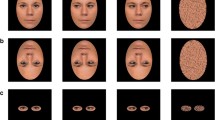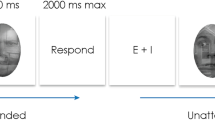Abstract
Research demonstrates an influence of gaze direction in emotion recognition. Here we examined whether facial affect similarly influences recognition of gaze direction. Across two studies we found that averted relative to direct gaze was processed more quickly and accurately when coupled with fear, and direct relative to averted gaze with anger. Also evident was that slower overall gaze processing was associated with increased interaction effects between emotion and gaze. Examining individual differences, therefore, enabled us to extend previous research examining speed of processing as a moderator of the interaction effect, while holding constant task demands and stimulus features. Unexpectedly, a main effect emerged such that averted relative to direct gaze was found to be processed more quickly and accurately overall. This effect was not moderated by processing speed and is discussed as a potential stimulus-driven effect that may help explain discrepant findings in the literature.
Similar content being viewed by others
Notes
When aggregating across studies, the effect size (weighted by df) for the comparison of direct gaze anger versus direct gaze fear reached significance, r(62) = .328, p < .01 (see Rosenthal and Rosnow 1991).
References
Adams, R. B., Jr., Ambady, N., Macrae, C. N., & Kleck, R. E. (2006). Emotional expressions forecast approach-avoidance behavior. Motivation and Emotion, 30, 177–186. doi:10.1007/s11031-006-9020-2.
Adams, R. B., Jr., Gordon, H. L., Baird, A. A., Ambady, N., & Kleck, R. E. (2003). Effects of gaze on amygdala sensitivity to anger and fear faces. Science, 300, 1536.
Adams, R. B., Jr., & Kleck, R. E. (2001). Young adult facial displays. Unpublished stimulus set, Dartmouth College.
Adams, R. B., Jr., & Kleck, R. E. (2003). Perceived gaze direction and the processing of facial displays of emotion. Psychological Science, 14, 644–647. doi:10.1046/j.0956-7976.2003.psci_1479.x.
Adams, R. B., Jr., & Kleck, R. E. (2005). Effects of direct and averted gaze on the perception of facially communicated emotion. Emotion (Washington, DC), 5, 3–11. doi:10.1037/1528-3542.5.1.3.
Argyle, M. (1967). The psychology of interpersonal behavior. Baltimore: Pelican Books.
Argyle, M., & Cook, M. (1976). Gaze and mutual gaze. New York: Cambridge University Press.
Baron-Cohen, S. (1995). Theory of mind and face-processing: How do they interact in development and psychopathology?. New York: Wiley.
Beaupré, M., Cheung, N., & Hess, U. (2000, October). La reconnaissance des expressions émotionnelles faciales par des décodeurs africains, asiatiques et caucasiens. Poster presented at the annual meeting of the Société Québécoise pour la Recherche en Psychologie, Hull, QC, Canada.
Bindemann, M., Burton, M. A., & Langton, S. R. H. (2008). How do eye gaze and facial expression interact? Visual Cognition, 16, 708–733. doi:10.1080/13506280701269318.
Driver, J., Davis, G., Ricciardelli, P., Kidd, P., Maxwell, E., & Baron-Cohen, S. (1999). Gaze perception triggers reflexive visuospatial orienting. Visual Cognition, 6, 509–540. doi:10.1080/135062899394920.
Ekman, P., & Friesen, W. V. (1975). Unmasking the face: A guide to recognizing emotions from facial clues. Englewood Cliffs, NJ: Prentice-Hall.
Ekman, P. F., & Friesen, W. V. (1978). The facial action coding system: A technique for the measurement of facial movement. Palo Alto, CA: Consulting Psychologists Press.
Ellsworth, P., & Ross, L. (1975). Intimacy in response to direct gaze. Journal of Experimental Social Psychology, 11, 592–613. doi:10.1016/0022-1031(75)90010-4.
Farroni, T., Csibra, G., Simion, F., & Johnson, M. H. (2002). Eye contact detection in humans from birth. Proceedings of the National Academy of Sciences of the United States of America, 99, 9602–9605. doi:10.1073/pnas.152159999.
Fox, E., Mathews, A., Calder, A. J., & Yiend, J. (2007). Anxiety and sensitivity to gaze direction in emotionally expressive faces. Emotion (Washington, DC), 7, 478–486. doi:10.1037/1528-3542.7.3.478.
Ganel, T., Goshen-Gottstein, Y., & Goodale, M. A. (2005). Interactions between the processing of gaze direction and facial expression. Vision Research, 45, 1191–1200. doi:10.1016/j.visres.2004.06.025.
Graham, R., & LaBar, K. S. (2007). Garner interference reveals dependencies between emotional expression and gaze in face perception. Emotion (Washington, DC), 7, 296–313. doi:10.1037/1528-3542.7.2.296.
Hadjikhani, N., Hodge, R., Snyder, J., & de Gelder, B. (2008). Pointing with the eyes: The role of gaze in communicating danger. Brain and Cognition, 68, 1–8. doi:10.1016/j.bandc.2008.01.008.
Haxby, J. V., Parasuraman, R., Lalonde, F., & Abboud, H. (1993). SuperLab: General-purpose Macintosh software for human experimental psychology and psychological testing. Behavior Research Methods, Instruments, & Computers, 25, 400–405.
Hess, U., Adams, R. B., Jr., & Kleck, R. E. (2007). When two do the same, it might not mean the same: The perception of emotional expressions shown by men and women. In U. Hess & P. Philippot (Eds.), Group dynamics and emoitonal expression: Studies in emotion and social interaction, second series (pp. 182–190). New York: Cambridge University Press.
Holmes, A., Richards, A., & Green, S. (2006). Anxiety and sensitivity to eye gaze in emotional faces. Brain and Cognition, 60, 282–294. doi:10.1016/j.bandc.2005.05.002.
Hori, E., Tazumi, T., Umeno, K., Kamachi, M., Kobayashi, T., Ono, T., et al. (2005). Effects of facial expression on shared attention mechanisms. Physiology & Behavior, 84, 397–405. doi:10.1016/j.physbeh.2005.01.002.
Janik, S. W., Wellens, A. R., Goldberg, M. L., & Dell’Osso, L. F. (1978). Eyes as the center of focus in the visual examination of human faces. Perceptual and Motor Skills, 47, 857–858.
Kendon, A. (1967). Some functions of gaze-direction in social interaction. Acta Psychologica, 26, 22–63. doi:10.1016/0001-6918(67)90005-4.
Kirouac, G., & Doré, F. Y. (1984). Judgment of facial expressions of emotion as a function of exposure time. Perceptual and Motor Skills, 59, 147–150.
Klucharev, V., & Sams, M. (2004). Interaction of gaze direction and facial expressions processing: ERP study. NeuroReport, 15, 621–625. doi:10.1097/00001756-200403220-00010.
Lobmaier, J. S., Tiddeman, S. P., & Perrett, D. I. (2008). Emotional expression modulates perceived gaze direction. Emotion (Washington, DC), 8, 573–577. doi:10.1037/1528-3542.8.4.573.
Macrae, C. N., Hood, B. M., Milne, A. B., Rowe, A. C., & Mason, M. F. (2002). Are you looking at me? Gaze and person perception. Psychological Science, 13, 460–464. doi:10.1111/1467-9280.00481.
Mathews, A., Fox, E., Yiend, J., & Calder, A. (2003). The face of fear: Effects of eye gaze and emotion on visual attention. Visual Cognition, 10, 823–835. doi:10.1080/13506280344000095.
Nummenmaa, T. (1964). The language of the face. Jyvaeskylae Studies in Education, Psychology, and Social Research, 9, 66.
Putman, P., Hermans, E., & van Honk, J. (2006). Anxiety meets fear in perception of dynamic expressive gaze. Emotion (Washington, DC), 6, 94–102. doi:10.1037/1528-3542.6.1.94.
Rosenthal, R., & Rosnow, R. (1991). Essentials of behavioral research: Methods and data analysis (2nd ed.). New York: McGraw-Hill.
Rubin, Z. (1973). Liking and loving: An invitation to social psychology. New York: Holt, Rinehart & Winston.
Sander, D., Grandjean, D., Kaiser, S., Wehrle, T., & Scherer, K. R. (2007). Interaction effects of perceived gaze direction and dynamic facial expression: Evidence for appraisal theories of emotion. The European Journal of Cognitive Psychology, 19, 470–480. doi:10.1080/09541440600757426.
Sato, W., Yoshikawa, S., Kochiyama, T., & Matsumura, M. (2004). The amygdala processes the emotional significance of facial expressions: An fMRI investigation using the interaction between expression and face direction. NeuroImage, 22, 1006–1013. doi:10.1016/j.neuroimage.2004.02.030.
Schneider, D. J., Hastorf, A. H., & Ellsworth, P. C. (1979). Person perception. Reading, MA: Addison-Wesley.
Senju, A., & Hasegawa, T. (2005). Direct gaze captures visuospatial attention. Visual Cognition, 12, 127–144. doi:10.1080/13506280444000157.
Tipples, J. (2006). Fear and fearfulness potentiate automatic orienting to eye gaze. Cognition and Emotion, 20, 309–320. doi:10.1080/02699930500405550.
Vuilleumier, P., George, N., Lister, V., Armony, J., & Driver, J. (2005). Effects of perceived mutual gaze and gender on face processing recognition memory. Visual Cognition, 12, 85–101. doi:10.1080/13506280444000120.
Whalen, P. J., Kagan, J., Cook, R. G., Davis, F. C., Kim, H., Polis, S., et al. (2005). Human amygdala responsivity to masked fearful eye whites. Science, 306, 2061. doi:10.1126/science.1103617.
Yoshikawa, S., & Sato, W. (2000). Face perception as a social message detector: Facilitation by emotional expression and gaze direction. Japanese Psychological Review, 43, 259–275.
Author information
Authors and Affiliations
Corresponding author
Rights and permissions
About this article
Cite this article
Adams, R.B., Franklin, R.G. Influence of emotional expression on the processing of gaze direction. Motiv Emot 33, 106–112 (2009). https://doi.org/10.1007/s11031-009-9121-9
Received:
Accepted:
Published:
Issue Date:
DOI: https://doi.org/10.1007/s11031-009-9121-9




